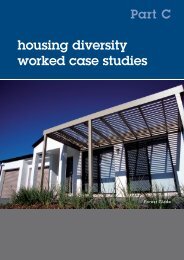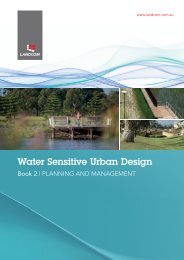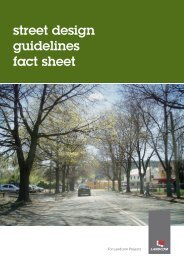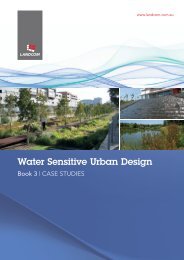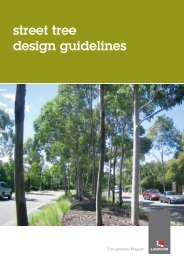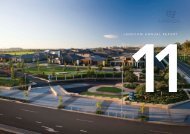SUSTAINABILITY REPORT - Landcom
SUSTAINABILITY REPORT - Landcom
SUSTAINABILITY REPORT - Landcom
You also want an ePaper? Increase the reach of your titles
YUMPU automatically turns print PDFs into web optimized ePapers that Google loves.
CASE STUDY<br />
PARK CENTRAL<br />
CREEK<br />
REHABILITATION<br />
WHY THE CREEK AT PARK CENTRAL GOT AN EXTREME MAKEOVER<br />
The creek that ran through the old Campbelltown Golf Course was highly degraded, with<br />
little vegetation growing along its corridor other than some exotic plant species. Weeds such<br />
as typhus were choking what remained of its flow.<br />
The ecological value of the area meant <strong>Landcom</strong> was obliged to mount a rescue operation<br />
of the creek’s 800-metre riparian corridor. The aim was to find an integrated urban and<br />
environmental outcome that would allow <strong>Landcom</strong> to restore the site’s natural bushland<br />
and wetland, create a “place” with a memorable feature and to build a new community.<br />
A riparian corridor is the land directly adjacent to a natural or artificial waterway. Such corridors<br />
provide a crucial link between land and water ecosystems. They provide food, shade and<br />
shelter for terrestrial wildlife and aquatic organisms; they bind soil to provide bank and bed<br />
stability; and they filter nutrients and sediments from entering a watercourse.<br />
“We didn’t have much to work with when we started,” says <strong>Landcom</strong> Development Director<br />
Michael Pring. “The aim was to treat the water entering the site, treat the water from the<br />
catchment of the site itself and make sure the water quality that left the site was no worse<br />
and preferably better than that entering the site. There was also a salinity issue because the<br />
ponds connect to saline groundwater. So we had to select salt-tolerant plants for the<br />
reconstructed corridor.”<br />
The reconstruction involved work at the head of the creek and around the existing bushland.<br />
<strong>Landcom</strong> built a large detention basin capable of retaining a one-in-100-year storm event, as<br />
well as an outlet that fed into a pool and then into a man-made wetland at the top of the site.<br />
The wetland comprises a macrophyte zone stocked with water plants that remove nutrients and impurities<br />
from the water.<br />
<strong>Landcom</strong> also had to ensure the passage of fish through the system, so culverts and light wells were built into<br />
the creek corridor to allow light to penetrate to the water. Using rock mattresses for the creek bed gave the<br />
watercourse a more natural base. Steps in the water level were made no more than 50mm so that after rain,<br />
fish could travel through the watercourse and get from one end of the site to the other.<br />
Today, this repaired riparian corridor is the focal point of Park Central, a 37-hectare <strong>Landcom</strong> development in<br />
the heart of the Campbelltown CBD. When complete, Park Central will comprise 400 residences: a mix of<br />
home offices, terrace houses, courtyard living and a waterway that has been transformed from a neglected<br />
drain to a focal feature.<br />
PARK CENTRAL<br />
33



